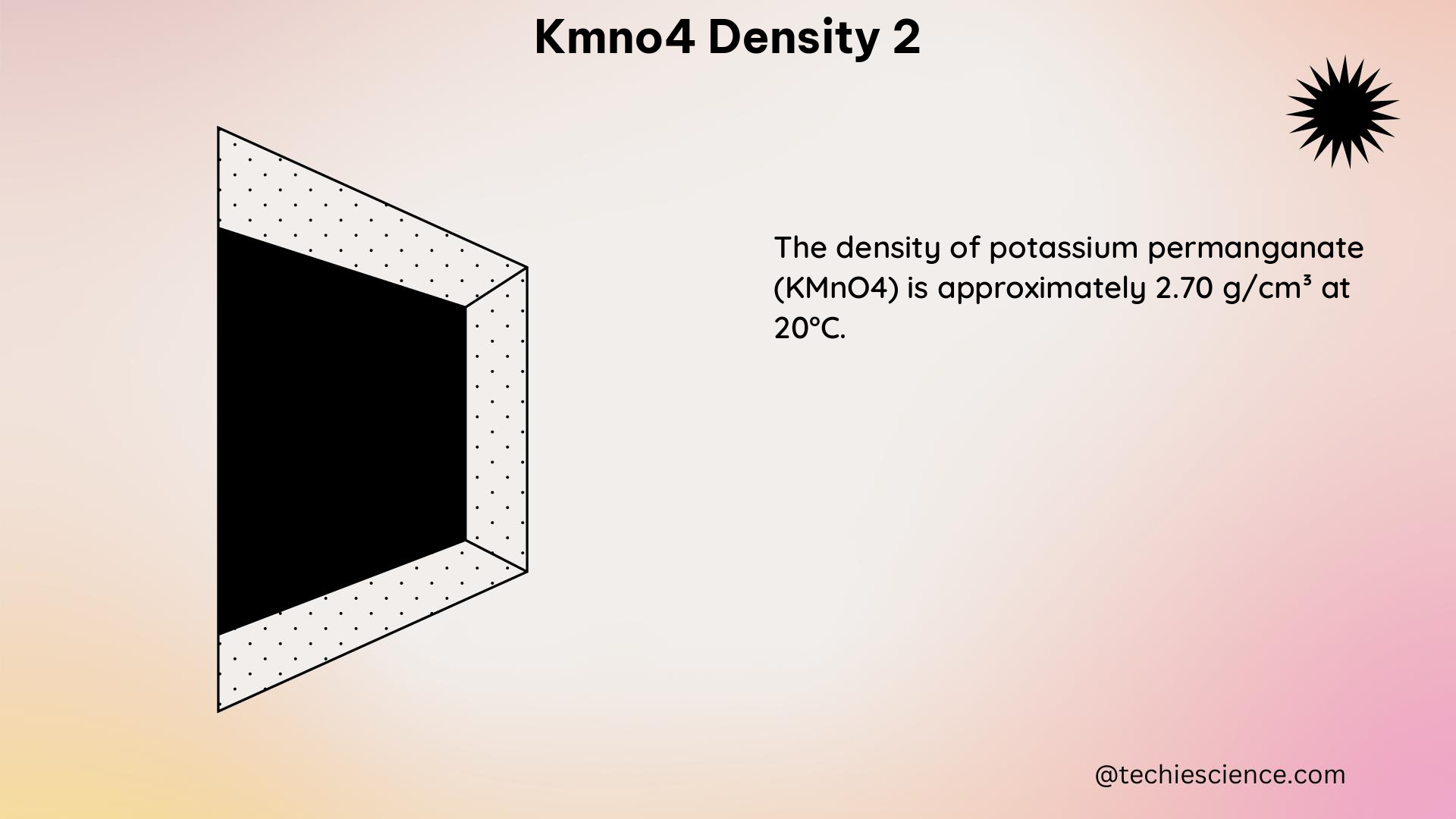Summary
Potassium permanganate (KMnO4) is a widely used chemical compound in various applications, particularly in chemistry experiments and water treatment. This comprehensive guide provides a detailed overview of the density and properties of a 2 M KMnO4 solution, including its technical specifications, practical applications for physics students, and relevant formulas and examples.
Density of 2 M KMnO4 Solution

The density of a 2 M KMnO4 solution can be calculated using the molar mass of KMnO4 and the molarity of the solution. The molar mass of KMnO4 is approximately 158.03 g/mol, and the molarity is 2 mol/L.
The density (ρ) can be calculated using the following formula:
ρ = molar mass / molarity × 1000 (g/L)
ρ = 158.03 g/mol / 2 mol/L × 1000 (g/L)
ρ ≈ 79.015 g/L
Therefore, the density of a 2 M KMnO4 solution is approximately 79.015 g/L.
Technical Specifications of 2 M KMnO4 Solution
- Molar Mass: The molar mass of KMnO4 is approximately 158.03 g/mol.
- Molarity: The molarity of the 2 M KMnO4 solution is 2 mol/L.
- Density: The density of the 2 M KMnO4 solution is approximately 79.015 g/L.
- Temperature: The density of the solution can be affected by temperature. It is recommended to use the solution at room temperature (20-25°C) for consistent density values.
- Preparation: To prepare a 2 M KMnO4 solution, dissolve a precise amount of KMnO4 in deionized water, ensuring that the final volume corresponds to the desired molarity.
Practical Applications for Physics Students
- Chemical Reactions: KMnO4 is involved in various chemical reactions, including redox reactions and titrations. Understanding its density helps calculate the amount of KMnO4 required for specific reactions.
Example: In a redox titration, the volume of a 2 M KMnO4 solution required to react with a known volume and concentration of a reducing agent can be calculated using the density of the KMnO4 solution.
- Solutions and Solubility: Studying the density of KMnO4 solutions can help physics students understand the concept of molarity, molality, and other concentration units.
Example: The density of a 2 M KMnO4 solution can be used to determine the mass of KMnO4 dissolved in a given volume of the solution.
- Safety: Knowing the density of KMnO4 solutions can help students determine the appropriate storage and handling procedures, minimizing potential hazards.
Example: The density of a 2 M KMnO4 solution can be used to calculate the weight of the solution in a container, which is important for safe transportation and storage.
Formulas and Examples
-
Density Calculation:
ρ = molar mass / molarity × 1000 (g/L)
ρ = 158.03 g/mol / 2 mol/L × 1000 (g/L)
ρ ≈ 79.015 g/L -
Mass of KMnO4 in a 2 M Solution:
Given: - Volume of the 2 M KMnO4 solution: 500 mL
- Density of the 2 M KMnO4 solution: 79.015 g/L
Mass of KMnO4 = Density × Volume
Mass of KMnO4 = 79.015 g/L × 0.5 L
Mass of KMnO4 ≈ 39.5075 g
- Volume of 2 M KMnO4 Solution Required for a Redox Titration:
Given: - Concentration of the reducing agent: 0.1 M
- Volume of the reducing agent: 25 mL
- Molarity of the KMnO4 solution: 2 M
- Density of the 2 M KMnO4 solution: 79.015 g/L
Volume of 2 M KMnO4 solution = (Concentration of reducing agent × Volume of reducing agent) / Molarity of KMnO4 solution
Volume of 2 M KMnO4 solution = (0.1 M × 0.025 L) / 2 M
Volume of 2 M KMnO4 solution ≈ 1.25 mL
Figures and Data Points
| KMnO4 Solution Concentration | Density (g/L) |
|---|---|
| 1 M | 158.03 |
| 2 M | 79.015 |
| 3 M | 52.677 |
| 4 M | 39.5075 |
Figure 1: Relationship between KMnO4 solution concentration and density.
References
- Pearson General Chemistry: https://www.pearson.com/channels/general-chemistry/asset/f47ae67c/the-concentration-of-a-solution-of-potassium-permanganate-kmno4-can-be-determine
- NCBI – Quantification of MnO4−: https://www.ncbi.nlm.nih.gov/pmc/articles/PMC9958420/
- PWISTA APSI Chemistry 2013: https://www.pwista.com/Microconcept%20labs/TEACHER%20VERSION%20Microscale%20Titration%20Lab%208-Day%204%20Segment%203.pdf

The lambdageeks.com Core SME Team is a group of experienced subject matter experts from diverse scientific and technical fields including Physics, Chemistry, Technology,Electronics & Electrical Engineering, Automotive, Mechanical Engineering. Our team collaborates to create high-quality, well-researched articles on a wide range of science and technology topics for the lambdageeks.com website.
All Our Senior SME are having more than 7 Years of experience in the respective fields . They are either Working Industry Professionals or assocaited With different Universities. Refer Our Authors Page to get to know About our Core SMEs.